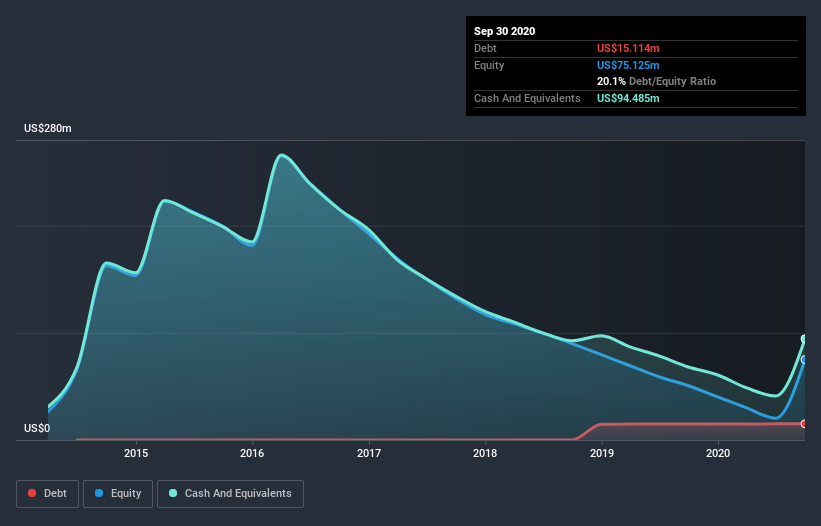Legendary fund manager Li Lu (who Charlie Munger backed) once said, 'The biggest investment risk is not the volatility of prices, but whether you will suffer a permanent loss of capital.' When we think about how risky a company is, we always like to look at its use of debt, since debt overload can lead to ruin. Importantly, Otonomy, Inc. (NASDAQ:OTIC) does carry debt. But is this debt a concern to shareholders?
What Risk Does Debt Bring?
Debt and other liabilities become risky for a business when it cannot easily fulfill those obligations, either with free cash flow or by raising capital at an attractive price. If things get really bad, the lenders can take control of the business. However, a more frequent (but still costly) occurrence is where a company must issue shares at bargain-basement prices, permanently diluting shareholders, just to shore up its balance sheet. Of course, the upside of debt is that it often represents cheap capital, especially when it replaces dilution in a company with the ability to reinvest at high rates of return. When we examine debt levels, we first consider both cash and debt levels, together.
View our latest analysis for Otonomy
What Is Otonomy's Debt?
As you can see below, Otonomy had US$15.1m of debt, at September 2020, which is about the same as the year before. You can click the chart for greater detail. However, its balance sheet shows it holds US$94.5m in cash, so it actually has US$79.4m net cash.

A Look At Otonomy's Liabilities
Zooming in on the latest balance sheet data, we can see that Otonomy had liabilities of US$10.8m due within 12 months and liabilities of US$29.3m due beyond that. Offsetting this, it had US$94.5m in cash and US$48.0k in receivables that were due within 12 months. So it actually has US$54.3m more liquid assets than total liabilities.
This excess liquidity suggests that Otonomy is taking a careful approach to debt. Because it has plenty of assets, it is unlikely to have trouble with its lenders. Succinctly put, Otonomy boasts net cash, so it's fair to say it does not have a heavy debt load! When analysing debt levels, the balance sheet is the obvious place to start. But ultimately the future profitability of the business will decide if Otonomy can strengthen its balance sheet over time. So if you want to see what the professionals think, you might find this free report on analyst profit forecasts to be interesting.
It seems likely shareholders hope that Otonomy can significantly advance the business plan before too long, because it doesn't have any significant revenue at the moment.
So How Risky Is Otonomy?
We have no doubt that loss making companies are, in general, riskier than profitable ones. And we do note that Otonomy had an earnings before interest and tax (EBIT) loss, over the last year. Indeed, in that time it burnt through US$38m of cash and made a loss of US$45m. But at least it has US$79.4m on the balance sheet to spend on growth, near-term. Even though its balance sheet seems sufficiently liquid, debt always makes us a little nervous if a company doesn't produce free cash flow regularly. There's no doubt that we learn most about debt from the balance sheet. But ultimately, every company can contain risks that exist outside of the balance sheet. For example, we've discovered 4 warning signs for Otonomy (2 can't be ignored!) that you should be aware of before investing here.
If you're interested in investing in businesses that can grow profits without the burden of debt, then check out this free list of growing businesses that have net cash on the balance sheet.
If you decide to trade Otonomy, use the lowest-cost* platform that is rated #1 Overall by Barron’s, Interactive Brokers. Trade stocks, options, futures, forex, bonds and funds on 135 markets, all from a single integrated account. Promoted
New: AI Stock Screener & Alerts
Our new AI Stock Screener scans the market every day to uncover opportunities.
• Dividend Powerhouses (3%+ Yield)
• Undervalued Small Caps with Insider Buying
• High growth Tech and AI Companies
Or build your own from over 50 metrics.
This article by Simply Wall St is general in nature. It does not constitute a recommendation to buy or sell any stock, and does not take account of your objectives, or your financial situation. We aim to bring you long-term focused analysis driven by fundamental data. Note that our analysis may not factor in the latest price-sensitive company announcements or qualitative material. Simply Wall St has no position in any stocks mentioned.
*Interactive Brokers Rated Lowest Cost Broker by StockBrokers.com Annual Online Review 2020
Have feedback on this article? Concerned about the content? Get in touch with us directly. Alternatively, email editorial-team (at) simplywallst.com.
About OTCPK:OTIC
Otonomy
Otonomy, Inc., a biopharmaceutical company, develops therapeutics for neurotology in the United States.
Mediocre balance sheet and slightly overvalued.
Market Insights
Community Narratives




